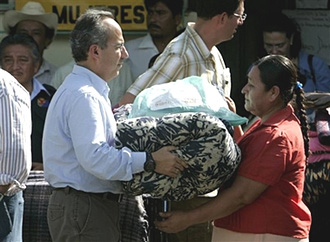 |
 |
 |
 News Around the Republic of Mexico | November 2007 News Around the Republic of Mexico | November 2007  
Calderón Blames Floods on Climate Change
 Cox News Cox News
go to original


| | Mexico's President Felipe Calderon delivers supplies for victims of the flood and the landslide of San Juan de Grijalva, in a shelter in Ostuacan, Mexico, Tuesday, Nov. 6, 2007. (AP/Eduardo Verdugo) |
Others condemn dams, corruption, mismanagement

Mexico City — In one of the country's worst flooding disasters, as many as 500,000 people are homeless and at least 10 are dead after rainwater and swollen rivers washed over 80 percent of Tabasco state last week.

But as cleanup efforts finally begin, exhausted residents and angry officials alike are pointing fingers.

President Felipe Calderón left no question where the blame should go: "I can assure Tabasqueños that the origin and cause of this catastrophe is enormous climate change," he said during a tour of the ravaged state. He called the flooding the result of three days of record-breaking rainfall.

But as in New Orleans after Hurricane Katrina, a growing number of observers here see man-made factors at work in Tabasco's tragedy: millions of dollars for flood control that apparently never was spent and questionable management of electricity-producing dams, which helped flood the Tabascan capital of Villahermosa.

Despite Tabasco's standing as one of Mexico's main oil- and electricity-generating states, little, it seems, was invested in protecting residents.

The floods produced at least $5 billion in economic losses, wiping out Mexico's largest banana crop and threatening Tabasco state's famed giant Olmec heads, an important cultural treasure and tourist draw.

For thousands of years the Grijalva River has nourished southern Mexico, providing trade routes and fishing grounds for Olmecs and Mayas.

More recently, the Grijalva watershed has nourished dams that produce about a quarter of Mexico's electricity, making it perhaps the nation's most economically important river.

Much of the post-flooding analysis has centered on the massive dams upriver of Villahermosa.

Calderón has received mixed reviews on his handling of the crisis. The Mexican president visited the affected zone three times in its earliest stages, but some say he didn't order enough federal troops to Tabasco. Some also blamed him for delays in aid reaching more-remote regions.

But most of the criticism has been directed at bureaucrats and past governors in Tabasco.

Days before the city of a half-million residents flooded, officials with Mexico's Federal Electricity Commission decided to release about 500,000 gallons of water per second from the spillway of the Peñitas Dam, sending water hurtling down the already swollen Grijalva River. Experts say the action helped send water over the Grijalva's banks, although they note that flooding also hit the city from the undammed Umascinta River.

Víctor Magaña, meteorologist with the National Autonomous University of Mexico, said dam officials should have expected heavy rains at the end of October because of a La Niña effect over the Pacific Ocean. Instead, officials kept the dams at high levels throughout October.

Yet criticism also is focusing on hundreds of millions of dollars in government money allocated for flood prevention since 1999, the last time Tabasco flooded severely.

That year 60 percent of the swampy, low-lying state flooded, leaving 186,000 without homes and neighborhoods underwater for five weeks.

In 2003, officials came up with a plan to protect Tabasco from flooding. The Reforma newspaper reported that some 50 flood control projects haven't begun, even though $100 million has been allocated. Most observers point to corruption in past state administrations in Tabasco (Granier took office earlier this year), including that of former governor and presidential candidate Roberto Madrazo. | 
 | |
 |



